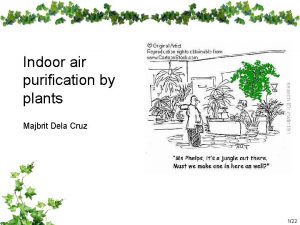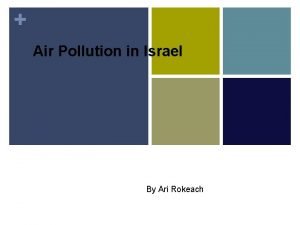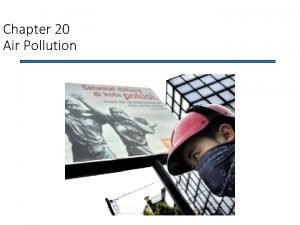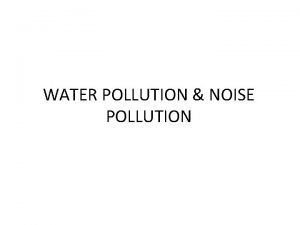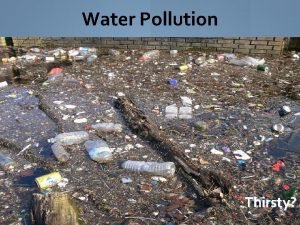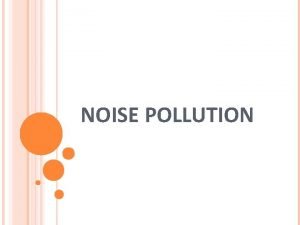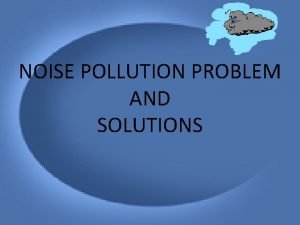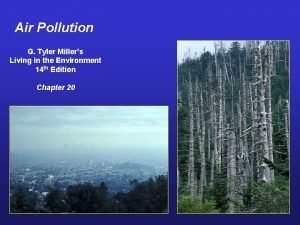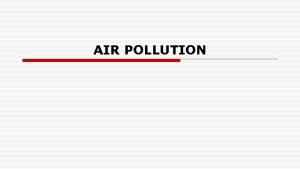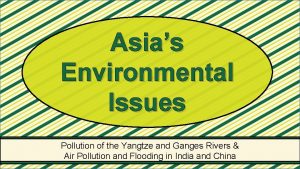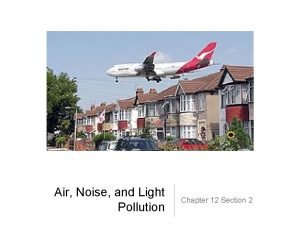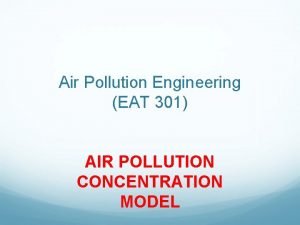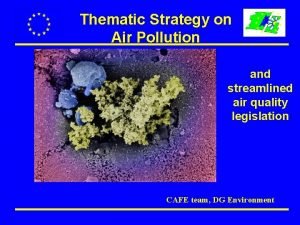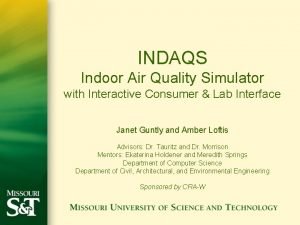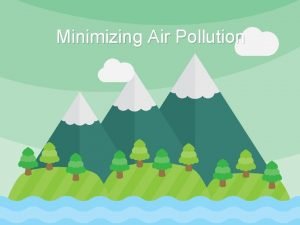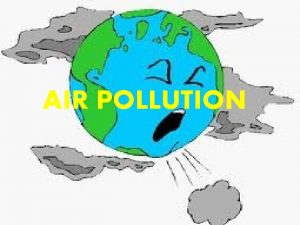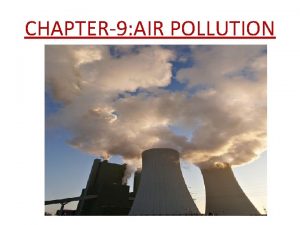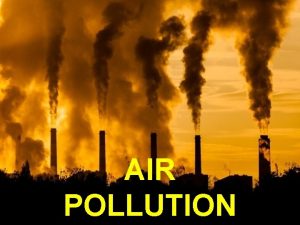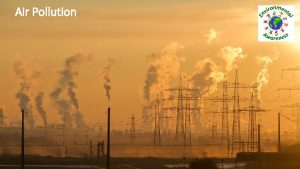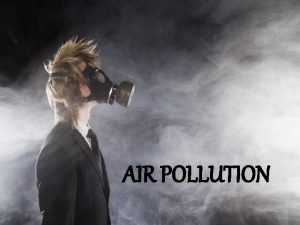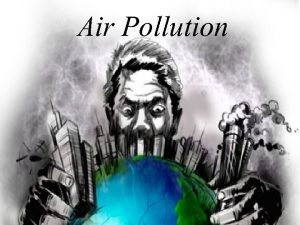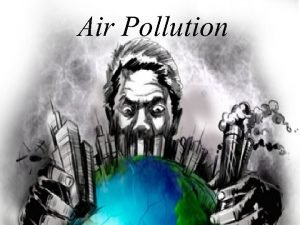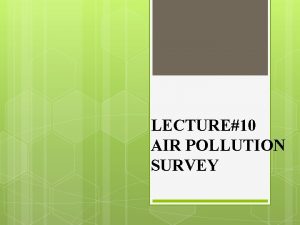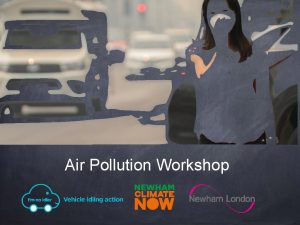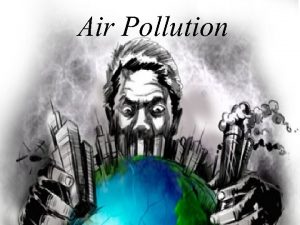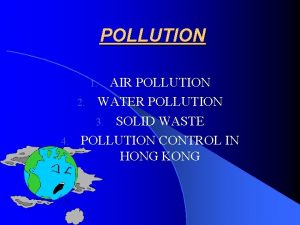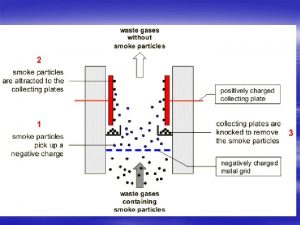Sources of Air Pollution Sources of Air Pollution
























- Slides: 24

Sources of Air Pollution

Sources of Air Pollution Indoor Outdoor

Sources of Air Pollution SOURCES Natural Sources • Arising due to natural causes like volcano, oceans, forest fire, dust storm, hot springs, pollens, spores, biogenic source (Smoky mountains) Anthropogenic Sources (Man made) • Arising due to man made activities 1. Regular/Process 1. Industrial sources (Stack/Tail pipe) 2. Vehicular sources 3. Domestic sources 2. Fugitive 4. Area sources (Non-point source)

Source Classification Sources may be classified as: (A) Primary Secondary (B) Combustion Non-combustion (C) Stationary Mobile (D) (1) Point sources (large stationary sources) (2) Area sources (small stationary sources and mobile sources with indefinite routes) (3) Line sources (mobile source with definite routes)

Source Classification Total sources Stationary sources Point sources 1. Industrial Processing 2. Power plants 3. Fuel combustion (Industrial) coal oil gas 4. Solid waste disposal 5. Municipal Incinerators 6. Open burning 7. Miscellaneous Area sources 1. Residential heating Coal Gas Oil 2. Institutional and Commercial heating Coal Oil Gas 3. On site incineration 4. Open burning 5. Evaporative losses 6. Miscellaneous Mobile sources Line sources 1. Highway vehicles 2. Railroad locomotives Area sources 1. Motor vehicles 2. High duty, Medium duty, heavy duty 3. Rail yard locomotives 4. Aircraft (Airports) 5. Miscellaneous

Natural Sources • • • Volcano Accidental fire Dust storms Ocean Plant and Trees

Volcano § An erupting volcano emits particulate matter. § SO 2, H 2 S and methane are also emitted. § Harms the environment for a considerable distance from the volcanic source. § PM and Gases remains air born for a long period of time.

Accidental Fire § Fire emits large quantities of pollutants in the form of smoke, unburned hydrocarbons, carbon monoxide, carbon dioxide, oxides of nitrogen, and ash. e. g. Forest fires in the Pacific Northwest of the United States have been observed to emit a plume which caused reduction in visibility and sunlight as far away as 350 km from the actual fire.

Accidental Fire

Dust storms § Dust storms that entrain large amounts of particulate matter. § Visibility reduction during major dust storms is cause of severe highway accidents and can even affect air travel. § The particulate matter transferred by dust storms from the desert to urban areas causes problems to householders, industry and automobiles.

Ocean § The ocean is continually emitting aerosols to the atmosphere, in the form of salt particles, which are corrosive to metals and paints. § The action of waves on rocks reduces them to sand, which may eventually become airborne. § Even the shells washed up on the beach are eroded by wave and tidal action until they are reduced to such a small size that they too may become airborne.

Plant and Trees § Green plants play a large part in the conversion of carbon dioxide to oxygen through photosynthesis; they are still the major source of hydrocarbons on the planet. § Blue haze over forested areas is nearly all from the atmospheric reactions of the volatile organics given off by the trees of the forest

Other Natural Sources § Other natural sources, such as alkaline and saltwater lakes, sulfurous gases from hot springs

Anthropogenic Source

Typical Industrial and other Sources Besides smoke, sulphur dioxide, oxides of nitrogen and fly ash, the following specific pollutants may also be found 1. Fertilizer industry and Hydrogen fluoride, ammonia, fluorides, aluminiummanufacturing fertilizer dust and sulphuric acid, mist plants 2. Lead casting and Tin, lead etc. fumes and oxides, solvents and melting, pigments etc. thinners 3. Heavy Chemical Industry Acid fumes like acid plants, synthetic fibre etc. 4. Tanneries and leather Mercaptants and sulphides industry 5. Cement industry Cement and lime dust

Typical Industrial and other Sources Besides smoke, sulphur dioxide, oxides of nitrogen and fly ash, the following specific pollutants may also be found 6. Paints and Pigments Nitrobenzene and aniline, thinners, solvents and base material 7. Coal tar industry Poly nuclear hydrocarbons and aerosols of tar 8. Paper and products 9. Refinery and Hydrogen sulphide, hydrocarbons, odours of petrochemical industry mercaptants paper Hydrogen sulphide, mercaptants 10. . Metallurgical industry Metallic fumes, dust

Petroleum Refining Operations can be classified into four basic procedures 1. Separation 2. Conversion 3. Treating 4. Blending

Petroleum Refining Oil Refining Technology 1. Separation 2. Conversion 3. Treating 4. Blending 5. Desulphurization 6. Lead Antiknock Additives

Petroleum Refining Types of emission 1. Smoke and Particulates matter 2. Hydrocarbons 3. Other gaseous compounds principally oxides of sulphur and Nitrogen

Petroleum Refining Sources and Control 1. Storage tanks 2. Catalyst Regeneration units 3. Loading facilities 4. Pumps and compressor 5. Blow down Systems, Flares and shut downs 6. Boilers and Process Heaters 7. Incinerators 8. Miscellaneous

Some Specific pollutants and their sources



Quiz § List down the different sources of air pollution surrounding you and give your suggestions to control it.
 Mobile sources definition
Mobile sources definition Indoor air pollution sources
Indoor air pollution sources Stationary and mobile sources of air pollution
Stationary and mobile sources of air pollution Sources of smog
Sources of smog Chapter 12 air section 1 what causes air pollution
Chapter 12 air section 1 what causes air pollution Chapter 12 section 3 acid precipitation
Chapter 12 section 3 acid precipitation Print sources of information
Print sources of information Water resources important
Water resources important Is noise pollution
Is noise pollution Three source of water
Three source of water Thermal pollution source
Thermal pollution source Solution of noise pollution
Solution of noise pollution Noise pollution
Noise pollution Underground water
Underground water Air higroskopis air kapiler dan air gravitasi
Air higroskopis air kapiler dan air gravitasi Air pollution
Air pollution Air pollution control methods
Air pollution control methods 5 effects of air pollution
5 effects of air pollution Section 2 air noise and light pollution
Section 2 air noise and light pollution Air pollution box model example
Air pollution box model example Thematic strategy on air pollution
Thematic strategy on air pollution Land water and air pollution
Land water and air pollution Prevention of indoor air pollution
Prevention of indoor air pollution Air pollution simulator
Air pollution simulator Air pollution
Air pollution

